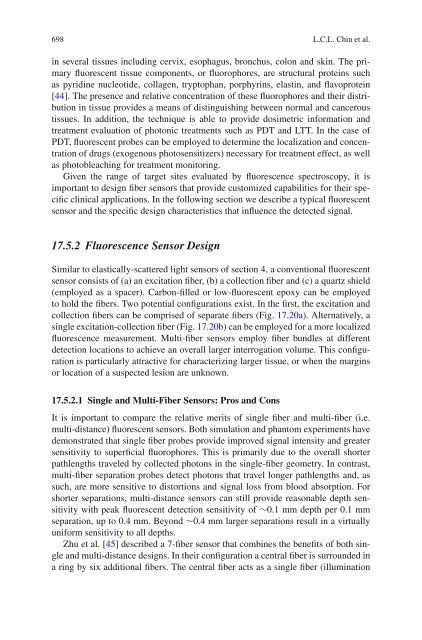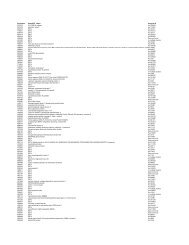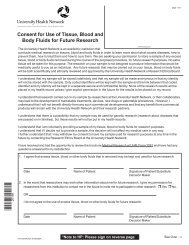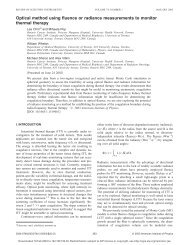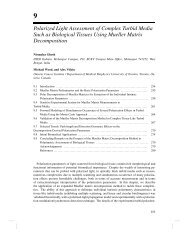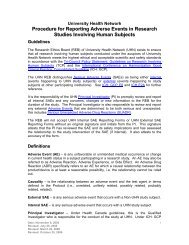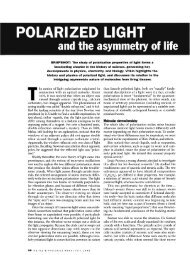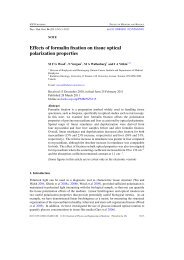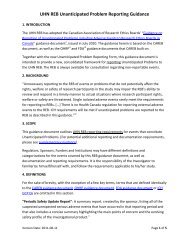Optical Fiber Sensors for Biomedical Applications
Optical Fiber Sensors for Biomedical Applications
Optical Fiber Sensors for Biomedical Applications
Create successful ePaper yourself
Turn your PDF publications into a flip-book with our unique Google optimized e-Paper software.
698 L.C.L. Chin et al.in several tissues including cervix, esophagus, bronchus, colon and skin. The primaryfluorescent tissue components, or fluorophores, are structural proteins suchas pyridine nucleotide, collagen, tryptophan, porphyrins, elastin, and flavoprotein[44]. The presence and relative concentration of these fluorophores and their distributionin tissue provides a means of distinguishing between normal and canceroustissues. In addition, the technique is able to provide dosimetric in<strong>for</strong>mation andtreatment evaluation of photonic treatments such as PDT and LTT. In the case ofPDT, fluorescent probes can be employed to determine the localization and concentrationof drugs (exogenous photosensitizers) necessary <strong>for</strong> treatment effect, as wellas photobleaching <strong>for</strong> treatment monitoring.Given the range of target sites evaluated by fluorescence spectroscopy, it isimportant to design fiber sensors that provide customized capabilities <strong>for</strong> their specificclinical applications. In the following section we describe a typical fluorescentsensor and the specific design characteristics that influence the detected signal.17.5.2 Fluorescence Sensor DesignSimilar to elastically-scattered light sensors of section 4, a conventional fluorescentsensor consists of (a) an excitation fiber, (b) a collection fiber and (c) a quartz shield(employed as a spacer). Carbon-filled or low-fluorescent epoxy can be employedto hold the fibers. Two potential configurations exist. In the first, the excitation andcollection fibers can be comprised of separate fibers (Fig. 17.20a). Alternatively, asingle excitation-collection fiber (Fig. 17.20b) can be employed <strong>for</strong> a more localizedfluorescence measurement. Multi-fiber sensors employ fiber bundles at differentdetection locations to achieve an overall larger interrogation volume. This configurationis particularly attractive <strong>for</strong> characterizing larger tissue, or when the marginsor location of a suspected lesion are unknown.17.5.2.1 Single and Multi-<strong>Fiber</strong> <strong>Sensors</strong>: Pros and ConsIt is important to compare the relative merits of single fiber and multi-fiber (i.e.multi-distance) fluorescent sensors. Both simulation and phantom experiments havedemonstrated that single fiber probes provide improved signal intensity and greatersensitivity to superficial fluorophores. This is primarily due to the overall shorterpathlengths traveled by collected photons in the single-fiber geometry. In contrast,multi-fiber separation probes detect photons that travel longer pathlengths and, assuch, are more sensitive to distortions and signal loss from blood absorption. Forshorter separations, multi-distance sensors can still provide reasonable depth sensitivitywith peak fluorescent detection sensitivity of ∼0.1 mm depth per 0.1 mmseparation, up to 0.4 mm. Beyond ∼0.4 mm larger separations result in a virtuallyuni<strong>for</strong>m sensitivity to all depths.Zhu et al. [45] described a 7-fiber sensor that combines the benefits of both singleand multi-distance designs. In their configuration a central fiber is surrounded ina ring by six additional fibers. The central fiber acts as a single fiber (illumination


